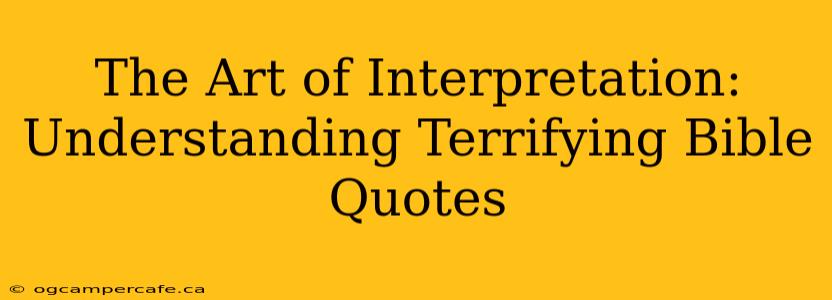The Bible, a cornerstone of faith for billions, contains passages that, taken out of context, can seem terrifying. From apocalyptic visions to pronouncements of divine wrath, these verses often spark fear and confusion. However, understanding the historical, cultural, and literary context is crucial to interpreting these passages accurately and avoiding misinterpretations that can lead to anxiety or a distorted view of God. This article will explore the art of biblical interpretation, focusing on how to approach seemingly frightening quotes and understand their true meaning.
Why Do Some Bible Quotes Seem Terrifying?
Many seemingly terrifying Bible quotes stem from the following factors:
- Literal vs. Figurative Language: The Bible employs various literary styles, including poetry, prophecy, and parable. What might seem like a literal threat of physical destruction could be figurative language representing spiritual decay or judgment.
- Cultural and Historical Context: Understanding the historical context of the text is essential. Many passages reflect the cultural norms and anxieties of the time, which might not directly translate to our modern understanding.
- Lack of Context: Taking a verse out of its surrounding paragraphs or chapters can drastically alter its meaning. Reading the entire passage, including the verses before and after, provides crucial context.
- Translation Issues: Different translations can subtly alter the meaning of a verse, leading to varying interpretations. Consulting multiple translations can offer a more nuanced understanding.
Commonly Misunderstood "Terrifying" Quotes and Their Interpretations
Let's address some commonly misunderstood passages often perceived as frightening:
"And I will show wonders in the heavens above and signs on the earth below, blood and fire and billows of smoke." (Acts 2:19)
This verse, often cited in discussions about the end times, describes the outpouring of the Holy Spirit on Pentecost. The "blood, fire, and billows of smoke" are symbolic imagery describing the powerful and transformative nature of the event, not a literal prediction of future catastrophe. The context within Acts 2 clarifies that this was a manifestation of God's power, not a sign of impending doom.
"The Lord is a man of war; the Lord is his name." (Exodus 15:3)
This verse, while seemingly aggressive, needs to be seen within the context of the Exodus narrative. It describes God's deliverance of the Israelites from slavery in Egypt. God's "war" in this context is a liberation from oppression, a battle against injustice, not a display of gratuitous violence. The verse highlights God's power to act on behalf of the oppressed.
"For I am the LORD your God, a jealous God, punishing the children for the sin of the parents to the third and fourth generation of those who hate me," (Exodus 20:5)
This verse, concerning God's jealousy, is frequently misinterpreted as a cruel punishment of innocent children. However, the term "jealousy" in this context refers to God's unwavering commitment to his covenant relationship. The "punishment" is often understood metaphorically as the consequences of societal and spiritual choices that impact future generations. The extended consequences of sin are not always direct but may manifest in the long-term effects on a community or lineage.
How to Approach Seemingly Terrifying Bible Quotes
Here's a framework for interpreting potentially frightening Bible passages:
- Read the entire passage: Don't isolate verses. Consider the context of the surrounding verses and chapters.
- Consider the literary genre: Is it poetry, prophecy, parable, historical narrative, or law? Different genres require different interpretive approaches.
- Research the historical and cultural background: Understanding the time period and culture helps to interpret the meaning within its original setting.
- Consult multiple translations: Different translations may offer subtle shifts in meaning. Compare various versions to gain a more comprehensive understanding.
- Seek guidance from trusted resources: Consult commentaries, theological studies, or experienced Bible teachers for further insight.
- Pray for understanding: Seek guidance from God through prayer as you study his word.
By carefully considering the context, employing critical thinking skills, and seeking wisdom from trusted sources, we can move beyond fear and discover the enriching and life-giving messages within even the most challenging biblical passages. The Bible is a book of hope and redemption, not just a collection of frightening prophecies. Understanding its nuances unlocks its profound wisdom and guidance.
